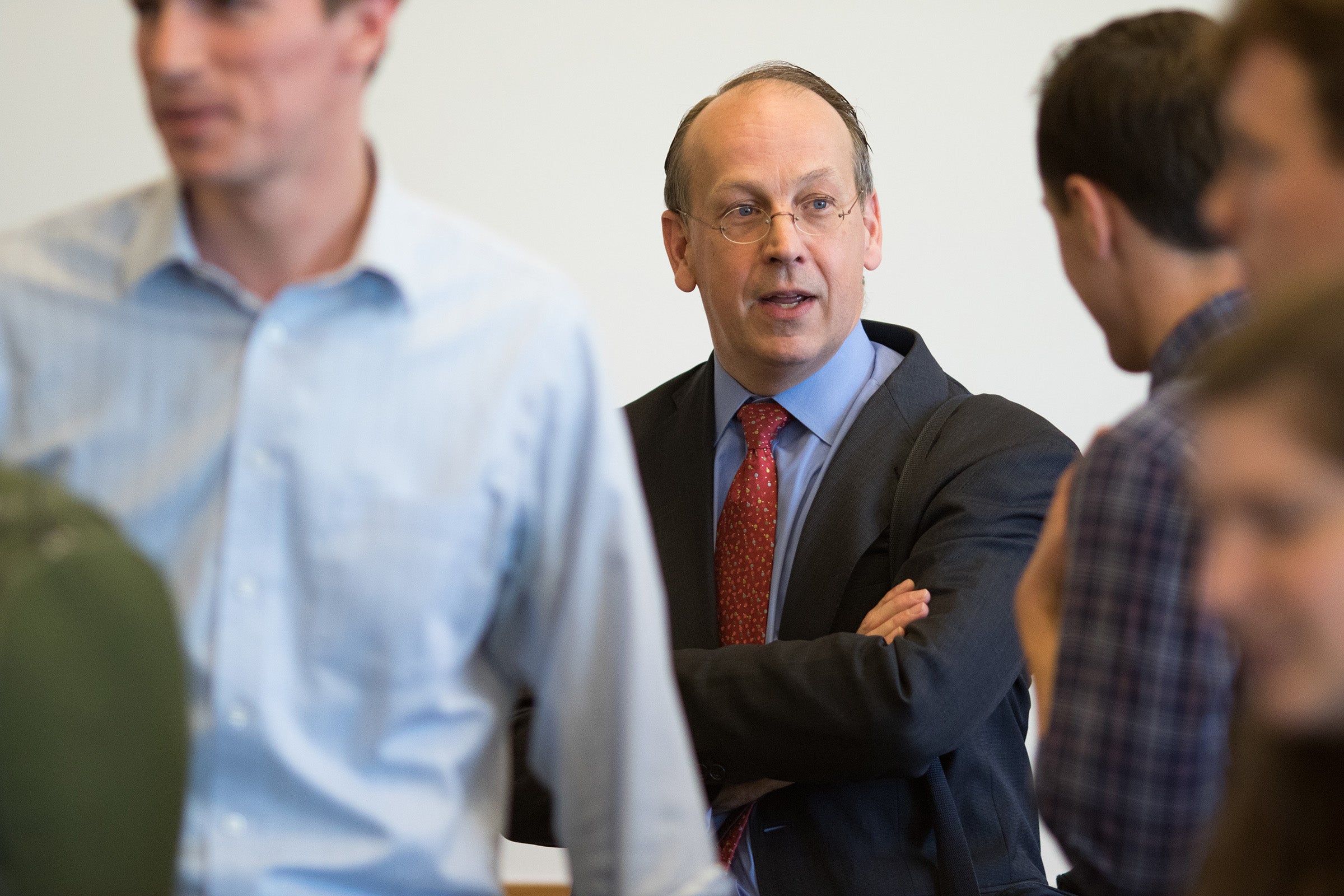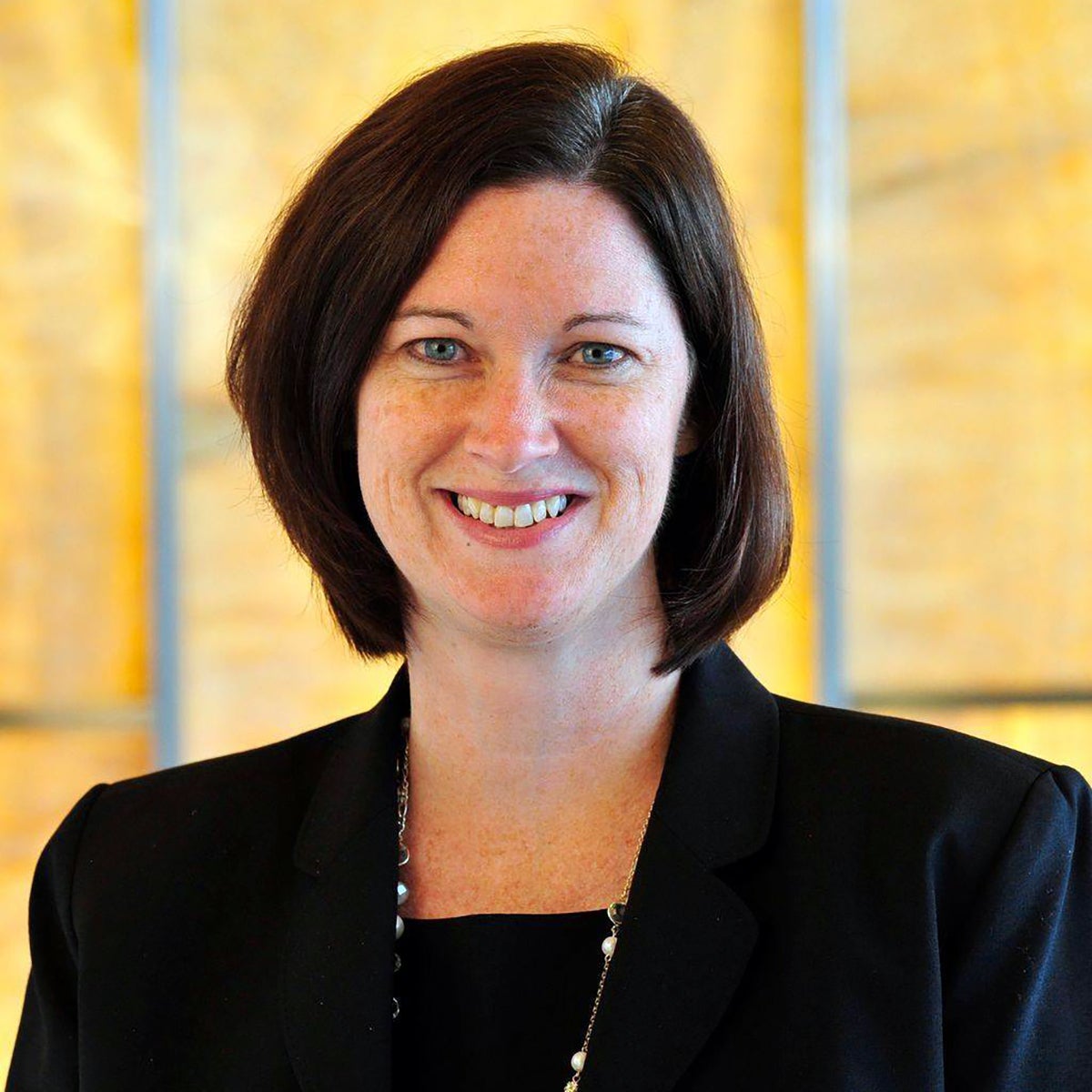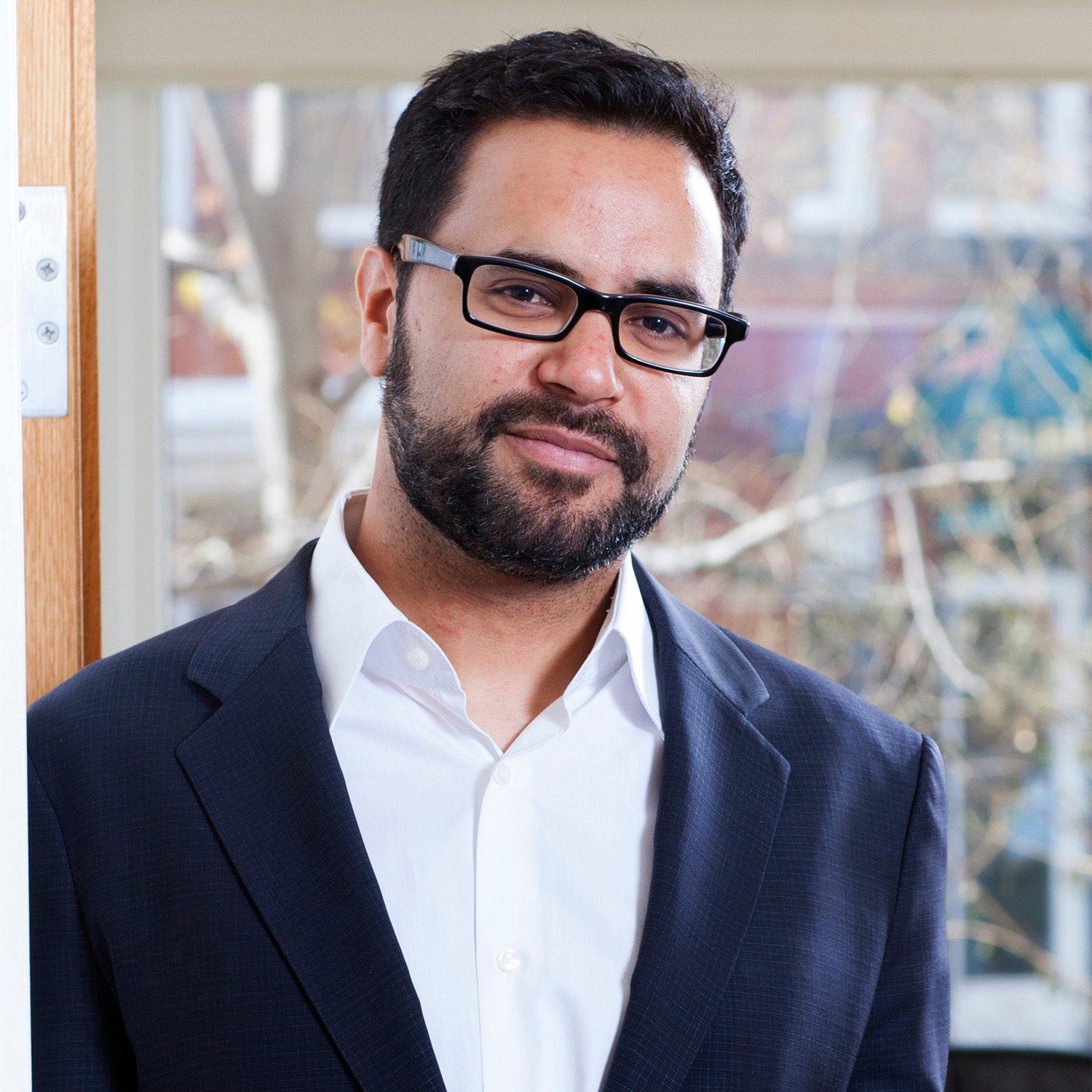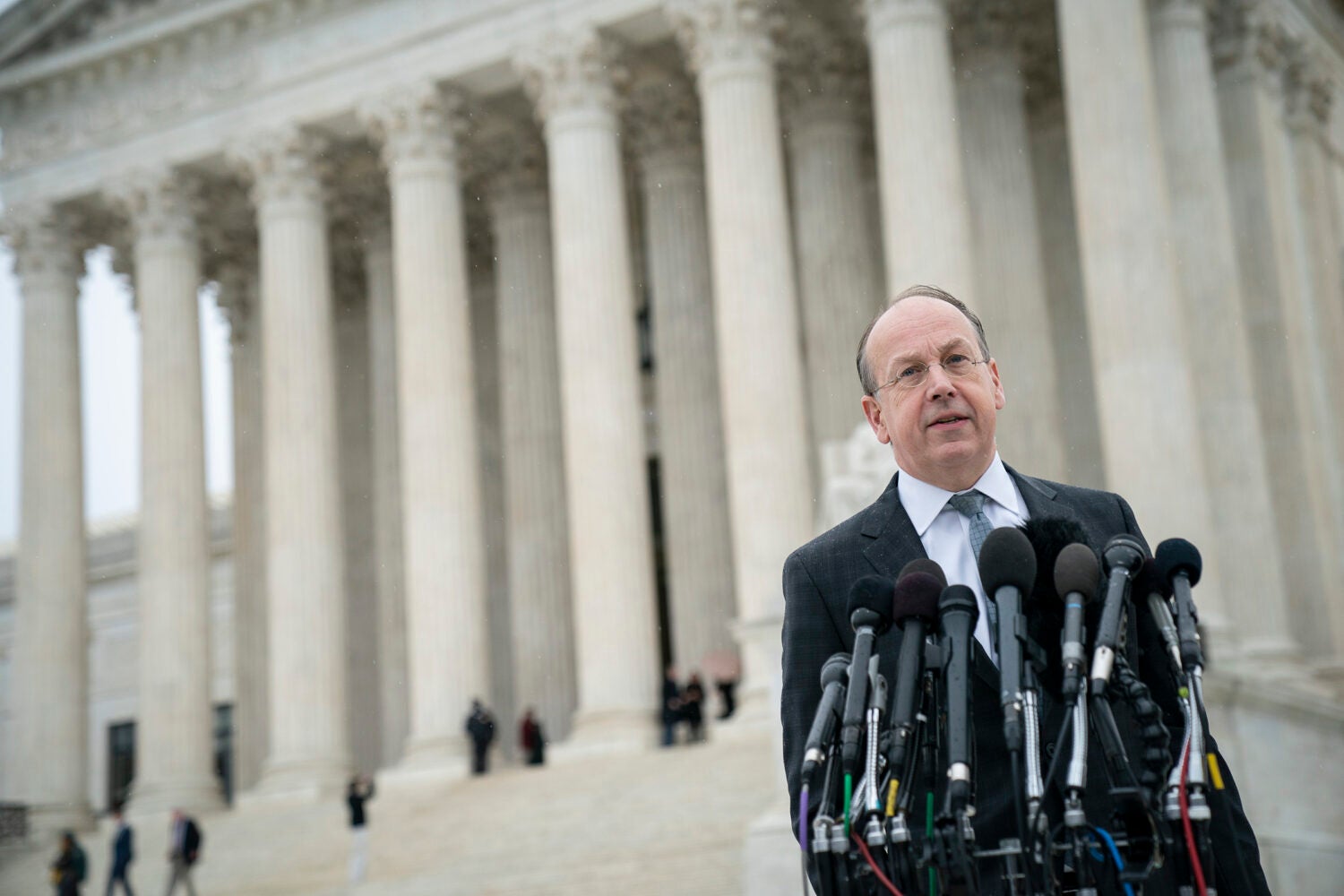You never forget the first time you argue in front of the Supreme Court of the United States. Or the second, or the third. Or the 112th, as Paul Clement ’92 will tell you.
“I think you actually remember every time you argue in front of the Supreme Court, no matter how many times you’re privileged to get to do it, because it’s always a very important professional experience,” says Clement, a former U.S. Solicitor General and a partner at Clement & Murphy in Washington, D.C.
The pre-argument jitters, the satisfying flow of a successful parley, the exhilaration when it is all over in what feels like both the blink of an eye and an eternity — these are just a few of the highs and lows described by some of the country’s top Supreme Court advocates. But what is it actually like to prepare for and present arguments to nine of the most important jurists in the country? Does it ever get any easier? And what happens when things go wrong?
First impressions
Clement presented his most recent case in front of the Supreme Court last November, though he wasn’t always the seasoned expert he is today. Before he was an advocate, Clement served as a law clerk to Justice Antonin Scalia ’60, where he observed lawyers in dozens of different cases, which enabled him to understand something about which techniques worked, and which did not.
But when it came time for his own debut before the Court, those observations, and his own preparation, could only alleviate some of the anxiety. “You’re obviously incredibly nervous,” says Clement.
Even the presence of his parents in the courtroom during that first case barely registered, he says. “Somebody said, ‘Won’t that make you nervous?’ But I couldn’t have been any more nervous.” However, that fear can actually be a gift, he adds. “You’re also exceptionally prepared precisely because you’re so nervous.”

Like many Supreme Court advocates, Clement’s preferred way of preparing is mooting — holding practice scenarios in which colleagues, other attorneys, and even those unfamiliar with the case stand in for the justices, interrupting one’s oral argument to ask questions and probe for weaknesses.
“Your moot courts are only going to be as good as the people you get to participate in them,” he says. “Ideally, what you want are other people who are picking up the briefs fresh, like the justices will, and who have argued Supreme Court cases themselves, so they have a good feel for the kind of questions the justices ask.”
He says there are many differences between arguing in the lower courts as opposed to the Supreme Court. At lower levels, “a lot of times you’re just arguing about what the Supreme Court meant in a particular precedent that the Court of Appeals has to follow, whether they like it or not.”
By contrast, a court of last resort naturally offers more freedom to help define what the law should be. It’s a power that not only impacts one’s clients but also sets important precedents that other Americans and courts will follow.
“You’re not going to have a long debate about what some prior case meant,” says Clement. “It’s much more about what the Court is going decide in this case. It’s certainly going to take into account precedent, and all of that, but sometimes it will consider overruling its precedent. So, you argue about stare decisis, but you are also very often talking about what legal rule is going to make sense for the whole system.”
And beyond the gravity of the decisions being made inside, the Supreme Court building itself adds to the weight of the proceedings. “The physical surroundings in the building are designed to inspire awe, and they succeed,” says Clement.
“You’re obviously incredibly nervous … You’re also exceptionally prepared precisely because you’re so nervous.”
Paul Clement ’92
For one thing, the justices sit much closer to the lawyers than one might imagine. “If the Chief Justice were to reach out and you were to reach out, you can just about touch fingertips,” says Clement. “It really is very physically intimate. And that physical aspect makes a difference.”
Despite the inherent seriousness of the Court, there are also moments of levity. Clement recounts a case he argued involving the scope of an implied cause of action – something Justice Scalia had taken issue with in a previous decision. “He had a famous line in one of his cases about the ‘bad old days of statutory construction,’ when the Court would infer judicially implied causes of action,” says Clement.
“We were having a conversation about this one case that I was relying on, and there was some confusion between the Justice and myself about when that case was decided and whether it was in the ‘bad old days’ when the Court used to be more freewheeling, or a more recent case. It happened to be a more recent case. But he asked me, ‘Well, Mr. Clement, when do you think the “bad old days” ended? And I said, ‘Justice Scalia, when you got on the Court.’”
It worked not just because it was a piece of flattery from a former law clerk to his boss, he says, but because “it was totally responsive to the question. The ‘bad old days’ did end when Justice Scalia got on the Court.”
Even with so much experience before the Court, Clement says he still gets nervous before an argument. And he’s happy about that. “If I didn’t get nervous, I’d start doing something else. I think you almost need the nerves — they’re what keep you going.”
The importance of being earnest
Oral arguments are a lot like fashion — everyone has their own style. And there’s no better place to hone one’s style than before the Supreme Court. For Jessica Ring Amunson ’04, the keys to a successful argument are honesty and directness. “I’m not someone who’s very bombastic or going to pound the table or anything like that,” she says. “I try to be forthright, to be of assistance to the Court. If I don’t actually know the answer to the question, I won’t try to avoid it or to fight the hypothetical,” says Amunson, who is a partner at Jenner & Block in Washington, D.C.
Her approach was visible during her first argument before the Court, when she received a question from Justice Anthony Kennedy ’61, who had written one of the major opinions related to a critical issue in her case. “He asked me to set forth the test that the Court should apply. Without specifically referencing the case, I used the exact language that he had written to outline the test and say how I thought the Court should apply it,” she says. “Before I could get out that it was from his opinion, he said, ‘I don’t understand that.’”

Amunson says she also prepares through mooting, because it helps her explore the issues from familiar and unexpected angles. But she says the most beneficial part comes after the exercise. “When you sit down and people critique your argument and say how you might have answered this differently, or how you might think about emphasizing something else – that is the most valuable part for me.”
She suggests that law students who are interested in Supreme Court advocacy explore opportunities for hands-on experience like Harvard’s Ames Moot Court Competition. After graduation, she adds, “Many people clerk or are in appellate practices. Others who end up arguing at the Supreme Court work for the government, either in the U.S. Solicitor General’s office or with state attorneys general.”
Amunson has argued in front of the Court twice. The first, in 2017, was a thrilling experience, she says. “It was a real honor and something that I had been looking forward to.”
“I’m not someone who’s very bombastic or going to pound the table or anything like that. I try to be forthright, to be of assistance to the Court.”
Jessica Ring Amunson ’04
Her second argument was also exciting, in a different way. Responding to the COVID pandemic, in 2020, the Court moved to telephone for oral arguments, a radical departure for an institution known for its consistency over the decades — and a unique challenge for advocates like Amunson.
As before, she worked with colleagues at her firm and at the Supreme Court Institute at Georgetown to practice by mooting, but this time, they did so on Zoom. “Everyone had their cameras off, so we could try to simulate what it might be like by phone,” she says. “I couldn’t see anyone’s facial expressions or other types of cues, which is how we expected it to be during the real thing.”
The structure of the arguments changed, too. Typically, the justices ask questions in any order they wish, jumping in when they see an opening or a weak point. But the telephone is less conducive to unstructured conversations, so justices proceeded in order of seniority. “Knowing who was coming up next, you could guess whether those questions were likely to be friendly or less friendly to your position,” she says.
On the day of the actual proceeding, Amunson, who argued the case from her basement, found herself with a few highly unusual — at least in historical terms — concerns. She says she had a landline installed in her home specifically for the argument, because she wanted to be sure that she had good audio quality and that her phone did not drop the call at an inopportune moment.
She also had to call off the leaf blowers. “I had a big sign on my door asking the UPS man not to ring the doorbell, and I checked with my neighbors prior to the day to be sure that no one was scheduling any kind of major landscaping or yard work or things like that,” she says.
‘You want time to get knocked down and build yourself back up’
Deepak Gupta, a lecturer on law at Harvard and founding principal of Gupta Wessler PLLC, has argued five Supreme Court cases, worked on dozens more, and filed more than 100 briefs with the Court. But he, too, can vividly recall his anxiety the first time he was to present oral arguments before the esteemed body. “I was in the Supreme Court cafeteria, and I remember looking down and seeing my hand shaking,” he says. “That was objective proof that I was indeed quite nervous.”
Thankfully, a colleague had a clever idea to help break the ice. “Before I got up to argue the case, I moved for the admission of one of my colleagues into the Supreme Court bar,” says Gupta, who co-teaches Harvard’s Supreme Court Litigation Clinic. “It meant that that was the first time I was speaking in open court, and it was a perfunctory motion. Those motions are always granted, so it reduced some of my nervousness.”

Like Clement and Amunson, Gupta says he is a “big believer in mooting arguments.” He makes an effort to find a wide variety of people with different viewpoints and ideological orientations, including those with little to no familiarity with his case.
His preparation begins with informal strategy sessions a few months out, because he prefers to keep the actual moots more formal. He also warns against starting too early. “I’m trying to create a sense of performance anxiety,” he says. “I’ll do them in a room that looks like a courtroom and dress as I would in court, trying to simulate the real thing.”
There’s an emotional arc to the preparation process, Gupta adds. “If you’re doing a rigorous schedule, there will be some moment where you just won’t have good answers to critical questions and that can make you feel really bad,” he says. “But you want that to happen, just not too close in time to the argument. You want time to get knocked down and build yourself back up.”
Although it may sound like acting, Gupta insists that an advocate’s style in the courtroom should reflect who they really are. “It’s the same reason that when you develop a voice as a writer, that voice has to have a relationship to the authentic you, otherwise you’re not going to be a very good writer.”
“There are advocates who come on very strong … I’m usually trying to slow things down, engage in a real conversation.”
Deepak Gupta
Gupta’s own arguing style is conversational. “There are advocates who come on very strong and maybe bring the temperature in the room up,” he says. “I’m usually trying to bring the temperature down. I want to slow things down, engage in a real conversation.”
The conversation is not just between the advocate and the justice who has asked a question, he says. “You’re talking to the whole Court, so you want to say something that is at once responsive to the justice but also persuasive to the entire bench.”
Gupta says he, too, presented an argument over the telephone during the pandemic, and hopes he will never have to repeat the experience. “I was most terrified that something would go wrong with the technology, and it did.”
The Court wanted a specific kind of phone connection, one his firm lacked, so he conducted the argument from another office. Gupta called in early so that an aide at the Court could test the line. He then set the phone to mute while he waited for his turn. But then, after four hours, the phone system abruptly disconnected. “Probably to avoid a zombie phone call that goes on for days,” he recalls. “But it cut off just as my opposing counsel was wrapping up and just seconds before I was supposed to start my argument.”
At first, Gupta wondered if the other side had accidentally hung up. “I felt bad for them. And then I realized, no wait, that’s us. I’m going to be leaving the nine justices of the Supreme Court waiting, which is not a good feeling.”
Luckily, the Supreme Court Clerk’s Office noticed what happened and helped get him back on the phone quickly. “The Chief Justice made a joke about it. He said, ‘You know, Mr. Gupta, we thought maybe you were going to be resting on your brief.’”
And there it was — the sheer panic of keeping the Court waiting had given Gupta the adrenaline rush he needed to begin.
Want to stay up to date with Harvard Law Today? Sign up for our weekly newsletter.
